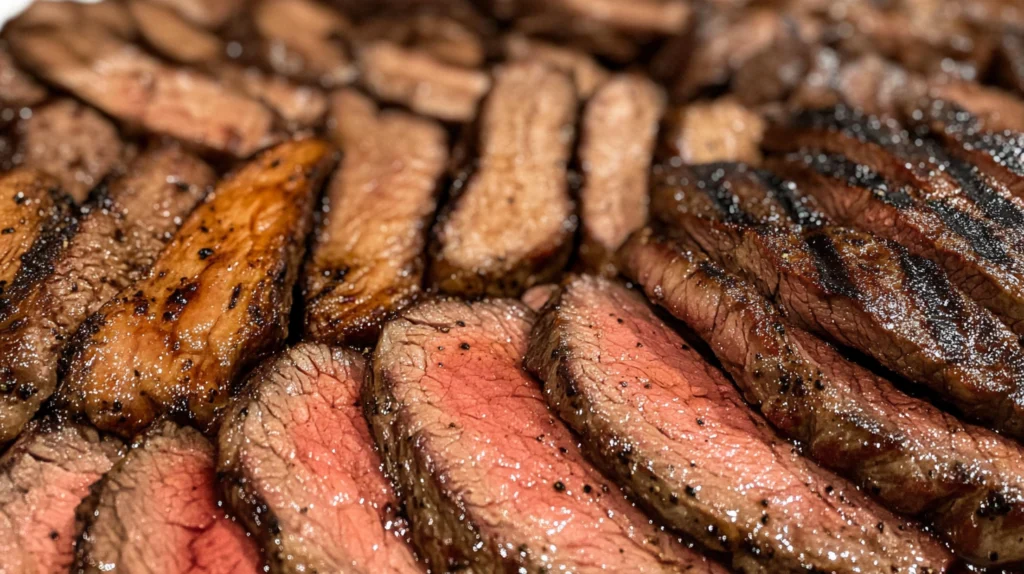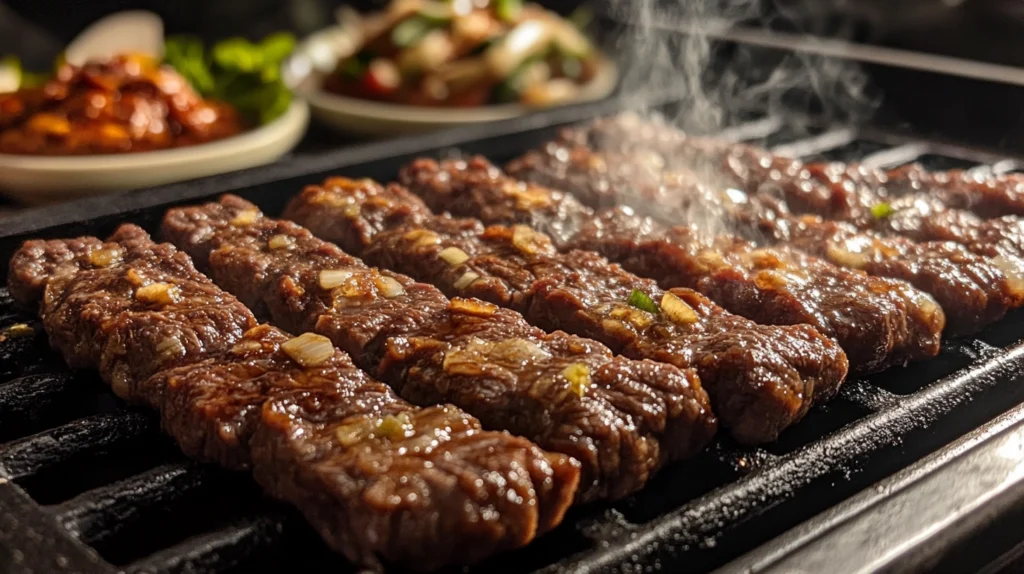Bulgogi, meaning “fire meat” in Korean, is a famous dish loved worldwide. It features tender slices of marinated meat grilled to perfection. Bulgogi is a staple in Korean cuisine and a highlight of Korean BBQ culture. The dish is often served with rice, wrapped in lettuce, or enjoyed with side dishes known as banchan. Its savory and slightly sweet flavor makes it irresistible.
The type of meat used is key to creating authentic bulgogi. Beef is the traditional choice, but other options like pork, chicken, or plant-based alternatives are also popular today. This article explores the best meat choices for bulgogi and offers tips for selecting the perfect cut for your next BBQ.
Traditional Meat Choices for Bulgogi
When it comes to making authentic bulgogi, the choice of meat plays a pivotal role. Traditionally, beef is the top pick, offering the ideal texture and flavor to complement the sweet and savory marinade. Several specific cuts of beef are preferred for bulgogi due to their tenderness, marbling, and ability to absorb the marinade. Let’s explore these cuts in detail.
For those interested in understanding more about beef, the article on what is beef sausage provides insights into beef-based dishes.
1. Ribeye: The Premium Choice
Ribeye is often regarded as the ultimate cut for bulgogi. It boasts a rich, buttery flavor thanks to its excellent marbling. The fat melts as the beef cooks, infusing the meat with moisture and enhancing its flavor. Thinly sliced ribeye is tender and cooks quickly, making it ideal for grilling or pan-frying.
2. Sirloin: A Balanced Option
Sirloin is another popular choice for bulgogi. It is slightly leaner than ribeye but still offers a good balance of flavor and tenderness. Sirloin slices are affordable and widely available, making them a practical option for home cooks preparing bulgogi for a crowd.
3. Brisket: A Unique Take
Brisket, though less common, is sometimes used in bulgogi recipes. Its robust flavor and slight chewiness add a rustic charm to the dish. When sliced thin and marinated properly, brisket absorbs the flavors beautifully and grills to a delightful texture.
4. Tenderloin: Lean and Mild
For those who prefer a leaner option, tenderloin is an excellent choice. It has a delicate flavor and a buttery texture that works well with bulgogi’s marinade. While tenderloin lacks the fattiness of ribeye or sirloin, it remains tender and flavorful when prepared correctly.
Why Thin Slicing Is Essential?
Regardless of the cut of beef you choose, slicing it thin is crucial for bulgogi. Thin slices cook quickly and evenly, preventing the meat from becoming tough. It also allows the marinade to penetrate deeply, ensuring every bite is packed with flavor. If you’re slicing the meat yourself, partially freezing it for 30 minutes beforehand makes it easier to achieve paper-thin cuts.
For detailed techniques on preparing thin meat cuts, check out baking thin-cut chicken breast.

Why Beef Is the Star of Bulgogi?
Beef has always been the traditional meat for bulgogi because of its flavor, texture, and natural pairing with Korean marinades. The marinade’s combination of soy sauce, sugar, sesame oil, garlic, and ginger enhances the rich taste of beef. This creates a perfect harmony of sweet, savory, and umami flavors.
1. Beef’s Flavor Profile
Beef delivers a deep, robust flavor that matches the boldness of bulgogi marinade. Marbling in cuts like ribeye and sirloin melts during cooking, adding richness and moisture. The process caramelizes the exterior while keeping the interior tender and juicy, making every bite satisfying and flavorful.
2. Texture: A Perfect Match
Beef offers a texture that pairs perfectly with bulgogi’s thin slicing and quick cooking style. Marbling in cuts like ribeye gives the meat a buttery mouthfeel, while leaner sirloin provides a firmer but still tender bite. When you cook thin slices evenly, they stay tender without turning chewy or dry.
3. Beef’s Cultural Significance
In Korean culture, people have historically regarded beef as a luxury, often saving it for celebrations or special occasions. Bulgogi, made with high-quality beef, reflects this cultural tradition of using premium ingredients. Families and friends often share this dish as a symbol of hospitality and care.
4. Versatility in Cooking
Cooks prepare beef bulgogi in many ways. Traditionally, people grill it over open flames to achieve a smoky, slightly charred flavor. Others prefer cooking it on a stovetop in a cast-iron skillet, which still caramelizes the marinade beautifully. Both methods highlight beef’s adaptability and elevate the dish’s flavor.
Modern Variations
Although beef remains the most popular choice, cooks have introduced many variations over the years. Some prefer fattier cuts for enhanced flavor, while others choose leaner options for a healthier twist. Despite these tweaks, beef continues to define bulgogi’s essence.
Learn more about incorporating beef into recipes with recipes with beef broth.

Exploring Alternative Meats for Bulgogi
While beef has traditionally been the star of bulgogi, modern interpretations of the dish include other meats. Chefs and home cooks alike experiment with pork, chicken, and even plant-based alternatives to cater to diverse tastes and dietary needs. These options bring new flavors and textures to bulgogi while maintaining the dish’s essence.
1. Chicken: A Leaner, Milder Alternative
Chicken bulgogi is another common adaptation, ideal for those seeking a leaner option. Boneless, skinless chicken thighs are the preferred choice due to their juiciness and ability to stay tender during cooking. Some recipes also use chicken breast for an even lighter version.
- Flavor Profile: Chicken’s mild taste allows the marinade to shine, making it a versatile choice for both traditional and spicy bulgogi.
- Cooking Tip: Avoid overcooking chicken to prevent it from drying out. Cook it over medium-high heat for a juicy, flavorful result.
2. Plant-Based Alternatives: A Modern Twist
In response to the growing demand for vegetarian and vegan options, many have embraced plant-based bulgogi. Ingredients like tofu, seitan, jackfruit, or soy protein serve as substitutes for meat. These options absorb the bulgogi marinade well, delivering a satisfying, umami-rich experience.
- Best Choices: Tofu and seitan are excellent for their ability to mimic the texture of meat. Jackfruit, on the other hand, works well for a pulled-meat effect.
- Cooking Tip: Press tofu to remove excess moisture before marinating, ensuring better absorption of flavors.
Comparing Meats for Bulgogi
| Meat Type | Best Cuts/Options | Flavor Profile | Ideal Cooking Style |
|---|---|---|---|
| Beef | Ribeye, sirloin, tenderloin | Rich, savory, tender | Grilled or pan-seared |
| Shoulder, belly, loin | Bold, fatty, slightly sweet or spicy | Grilled or stir-fried | |
| Chicken | Boneless thighs or breasts | Mild, juicy, absorbs marinade well | Grilled or skillet-cooked |
| Plant-Based | Tofu, seitan, jackfruit | Umami-rich, adaptable to marinades | Stir-fried or pan-seared |
Choosing the Right Meat for You
When deciding on a meat for bulgogi, consider the flavor, texture, and dietary preferences of your guests. Beef remains a classic, but pork, chicken, and plant-based options allow for flexibility. No matter the choice, the marinade ties everything together, creating the signature bulgogi taste.
How to Prepare Meat for Bulgogi?
The preparation process is crucial to achieving tender, flavorful bulgogi. From slicing the meat to marinating it correctly, each step contributes to the dish’s final texture and taste. Follow these detailed guidelines to prepare your meat like a pro.
1. Selecting the Right Cut
Choosing the right cut of meat is the first step. Opt for tender cuts with a balance of fat and lean meat. Cuts like ribeye or sirloin work best for beef, while pork shoulder and chicken thighs are excellent alternatives. For plant-based bulgogi, firm tofu or seitan are great options.
- Pro Tip: When buying meat for bulgogi, ask your butcher to slice it thinly or use pre-sliced options available in some Asian grocery stores.
2. Thin Slicing for Maximum Flavor
Thinly slicing the meat ensures it cooks quickly and absorbs the marinade deeply. This technique is especially important for beef and pork, as it highlights their tenderness while preventing toughness.
- How to Slice Meat for Bulgogi:
- Chill the meat in the freezer for 30–45 minutes to firm it up. This makes it easier to slice.
- Use a sharp knife to cut against the grain for beef or pork. This shortens the muscle fibers, making the meat more tender.
- Aim for slices that are about 1/8 inch thick for the perfect texture.
3. Preparing the Marinade
The marinade is what transforms plain meat into bulgogi. Its balanced combination of sweet, salty, and savory flavors infuses the meat, enhancing its natural taste. A classic bulgogi marinade includes the following ingredients:
- Soy sauce (saltiness and umami)
- Sugar or honey (sweetness and caramelization)
- Sesame oil (rich aroma and flavor)
- Garlic and ginger (spicy and earthy notes)
- Pear or apple puree (natural sweetness and tenderizing effect)
- Pro Tip: Add finely sliced green onions and sesame seeds for extra aroma and texture.
4. Marinating the Meat
Marinating allows the flavors to penetrate deeply, ensuring every bite bursts with flavor. Here’s how to marinate your meat for bulgogi:
- Place the sliced meat in a large bowl or resealable bag.
- Pour the prepared marinade over the meat, ensuring all slices are coated evenly.
- Let the meat marinate in the refrigerator for at least 30 minutes. For best results, marinate it for 2–4 hours. Beef can marinate overnight for a richer flavor.
- Stir or massage the meat occasionally to distribute the marinade evenly.
5. Cooking the Meat
The way you cook the meat affects the dish’s final taste and texture. Bulgogi is typically grilled or stir-fried, with each method offering a unique flavor profile.
- Grilling: Use a traditional Korean grill or a stovetop grill pan. High heat caramelizes the marinade, creating a smoky, slightly charred flavor.
- Stir-Frying: Heat a large skillet or wok over medium-high heat. Add the marinated meat and cook in batches to prevent overcrowding, ensuring even cooking.
Tips for Perfect Bulgogi
- Cook the meat quickly over high heat to retain its juiciness.
- Avoid overcooking, as this can make the meat tough.
- Serve immediately for the best flavor and texture.
Frequently Asked Questions About Bulgogi Meat and Conclusion
To wrap up, let’s address some common questions about bulgogi meat. These answers will help you refine your approach to making this classic dish and ensure your bulgogi is a success every time.
FAQs About Bulgogi Meat
1. Can I Use Frozen Meat for Bulgogi?
Yes, you can use frozen meat, but it’s best to partially thaw it before slicing. When the meat is partially frozen, it becomes much easier to cut into thin slices, which are essential for bulgogi. After slicing, be sure to let the meat marinate thoroughly so the flavors penetrate fully.
2. What’s the Best Substitute for Beef in Bulgogi?
Pork and chicken are the most common substitutes for beef. For instance, pork shoulder or belly provides a rich, fatty flavor that pairs well with the marinade, while chicken thighs offer a leaner option. On the other hand, vegetarians can opt for tofu or seitan, which also absorb the marinade beautifully.
3. How Long Should I Marinate the Meat?
The ideal marinating time depends on the type of meat. For example, beef benefits from a longer marinating time, usually 2–4 hours or even overnight. In contrast, pork and chicken require at least 30 minutes to 2 hours. Meanwhile, plant-based proteins like tofu absorb flavors more quickly and need only 30–60 minutes.
4. Can I Cook Bulgogi Without a Grill?
Absolutely! If you don’t have a grill, there are several alternatives. You can use a cast-iron skillet, a wok, or even a nonstick pan. Cook the meat over medium-high heat to achieve caramelization and a slight char. Additionally, stir-frying the meat in small batches ensures even cooking and helps preserve its juiciness.
5. Why Does the Marinade Include Fruit?
Fruits like Asian pear or apple are traditional ingredients in bulgogi marinade. Not only do they add natural sweetness, but they also help tenderize the meat by breaking down its proteins. If you can’t find these fruits, you can substitute pineapple or kiwi sparingly, as they have stronger tenderizing properties.
6. What Side Dishes Pair Best with Bulgogi?
Bulgogi pairs beautifully with steamed rice and traditional Korean side dishes (banchan). For example, kimchi, seasoned spinach (sigeumchi namul), and pickled radishes complement the dish perfectly. Additionally, serving bulgogi with lettuce wraps and ssamjang (a Korean dipping sauce) adds a fresh and flavorful twist to the meal.
Conclusion: Savoring the Best Bulgogi Experience
In conclusion, bulgogi is more than just a dish; it’s a celebration of flavor, tradition, and shared moments around the table. Whether you stick with the classic choice of beef or explore alternative options like chicken, or plant-based proteins, the essence of bulgogi lies in its rich marinade and careful preparation.
Discover unique ways to use chicken in various dishes by exploring thin chicken breast recipes.
By selecting the right meat, slicing it thinly, and marinating it to perfection, you can recreate the authentic taste of bulgogi in your own kitchen. Furthermore, pairing it with rice and traditional side dishes completes the experience and elevates your meal. Finally, no matter which variation you choose, bulgogi is sure to delight the senses and bring people together.

